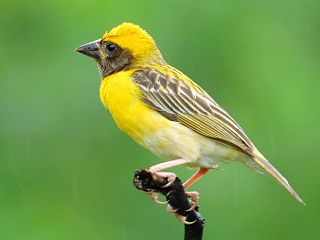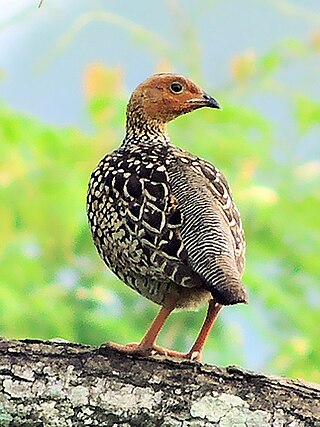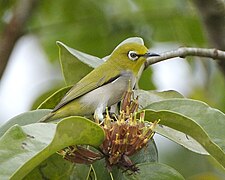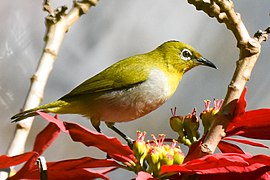
The Asian green bee-eater, also known as little green bee-eater, and green bee-eater in Sri Lanka, is a near passerine bird in the bee-eater family. It is resident but prone to seasonal movements and is found widely distributed across Asia from coastal southern Iran east through the Indian subcontinent to Vietnam. Populations in Africa and the Arabian Peninsula that were formerly assigned to this species are now considered distinct species: the African green bee-eater and the Arabian green bee-eater. They are mainly insect eaters and they are found in grassland, thin scrub and forest often quite far from water. Several regional plumage variations are known and several subspecies have been named.

The shikra is a small bird of prey in the family Accipitridae found widely distributed in Asia and Africa where it is also called the little banded goshawk. The African forms may represent a separate species but have usually been considered as subspecies of the shikra. The shikra is very similar in appearance to other falcons species including the Chinese goshawk and Eurasian sparrowhawk. They have a sharp two note call and have the typical flap and glide flight. Their calls are imitated by drongos and the common hawk-cuckoo resembles it in plumage.

The Sri Lanka frogmouth, Sri Lankan frogmouth or Ceylon frogmouth is a small frogmouth found in the Western Ghats of south India and Sri Lanka. Related to the nightjars, it is nocturnal and is found in forest habitats. The plumage coloration resembles that of dried leaves and the bird roosts quietly on branches, making it difficult to see. Each has a favourite roost that it uses regularly unless disturbed. It has a distinctive call that is usually heard at dawn and dusk. The sexes differ slightly in plumage.

The white-throated kingfisher also known as the white-breasted kingfisher is a tree kingfisher, widely distributed in Asia from the Sinai east through the Indian subcontinent to China and Indonesia. This kingfisher is a resident over much of its range, although some populations may make short distance movements. It can often be found well away from water where it feeds on a wide range of prey that includes small reptiles, amphibians, crabs, small rodents and even birds. During the breeding season they call loudly in the mornings from prominent perches including the tops of buildings in urban areas or on wires.

The black eagle is a bird of prey. Like all eagles, it is in the family Accipitridae, and is the only member of the genus Ictinaetus. They soar over forests in the hilly regions of tropical and subtropical South and Southeast Asia, as well as southeastern China. They hunt mammals and birds, particularly at their nests. They are easily identified by their widely splayed and long primary "fingers", the characteristic silhouette, slow flight and yellow ceres and legs that contrast with their dark feathers.

The Indian nightjar is a small nightjar which is a resident breeder in open lands across South Asia and Southeast Asia. Like most nightjars it is crepuscular and is best detected from its characteristic calls at dawn and dusk that have been likened to a stone skipping on a frozen lake - a series of clicks that become shorter and more rapid. They are sometimes spotted on roads when their eyes gleam red in the spotlight of a vehicle. There is considerable plumage variation across its range and can be hard to differentiate from other nightjars in the region especially in the field.

The black-rumped flameback, also known as the lesser golden-backed woodpecker or lesser goldenback, is a woodpecker found widely distributed in the Indian subcontinent. It is one of the few woodpeckers that are seen in urban areas. It has a characteristic rattling-whinnying call and an undulating flight. It is the only golden-backed woodpecker with a black throat and a black rump.

The purple sunbird is a small bird in the sunbird family found mainly in South and Southeast Asia but extending west into parts of the Arabian peninsula. Like other sunbirds they feed mainly on nectar, although they will also take insects, especially when feeding young. They have a fast and direct flight and can take nectar by hovering like a hummingbird but often perch at the base of flowers. The males can appear all black in harsh sunlight but the purple iridescence is visible on closer observation or under good light conditions. Females are olive above and yellowish below.

The purple-rumped sunbird is a sunbird endemic to the Indian Subcontinent. Like other sunbirds, they are small in size, feeding mainly on nectar but sometimes take insects, particularly when feeding young. They can hover for short durations but usually perch to lap nectar from flowers. They build a hanging pouch nest made up of cobwebs, lichens and plant material. Males are contrastingly coloured but females are olive above and yellow to buff below. Males are easily distinguished from the purple sunbird by the light coloured underside while females can be told apart from males by their whitish throats.

The yellow-billed babbler is a member of the family Leiothrichidae endemic to southern India and Sri Lanka. The yellow-billed babbler is a common resident breeding bird in Sri Lanka and southern India. Its habitat is scrub, cultivation and garden land. This species, like most babblers, is not migratory, and has short rounded wings and a weak flight and is usually seen calling and foraging in groups. It is often mistaken for the jungle babbler, whose range overlaps in parts of southern India, although it has a distinctive call and tends to be found in more vegetated habitats. Its name is also confused with Turdoides leucocephala, which is also known as white-headed babbler.

The Indian scimitar babbler is an Old World babbler. It is found in peninsular India in a range of forest habitats. They are most often detected by their distinctive calls which include an antiphonal duet by a pair of birds. They are often hard to see as they forage through dense vegetation. The long curved yellow, scimitar-shaped bills give them their name. It has been treated in the past as subspecies of the white-browed scimitar babbler which is found along the Himalayas but now separated into two species, the peninsular Indian species and the Sri Lanka scimitar babbler.

The brahminy starling or brahminy myna is a member of the starling family of birds. It is usually seen in pairs or small flocks in open habitats on the plains of the Indian subcontinent.

The Indian robin is a species of passarine bird in the family Muscicapidae. It is widespread in the Indian subcontinent and ranges across Bangladesh, Bhutan, India, Nepal, Pakistan and Sri Lanka. The males of the northern subspecies have brown backs whose extent gradually reduces southwards, with the males of the southern subspecies having all-black backs. They are commonly found in open scrub areas and often seen running along the ground or perching on low thorny shrubs and rocks. The long tail is usually held up and the chestnut undertail coverts and dark body make them easily distinguishable from pied bushchats and Oriental magpie-robins.

The Oriental magpie-robin is a small passerine bird that was formerly classed as a member of the thrush family Turdidae, but now considered an Old World flycatcher. They are distinctive black and white birds with a long tail that is held upright as they forage on the ground or perch conspicuously. Occurring across most of the Indian subcontinent and parts of Southeast Asia, they are common birds in urban gardens as well as forests. They are particularly well known for their songs and were once popular as cagebirds.

The Indian blue robin is a small bird found in the Indian Subcontinent. Formerly considered a thrush, it is now considered one of the Old World flycatchers in the family Muscicapidae. It was earlier also called the Indian blue chat. It is migratory, breeding in the forests along the Himalayas of Nepal, India, Myanmar and Bangladesh. They winter in the hill forests of the Western Ghats of India and in Sri Lanka.

The thick-billed flowerpecker is a tiny bird in the flowerpecker group. They feed predominantly on fruits and are active birds that are mainly seen in the tops of trees in forests. It is a resident bird with a wide distribution across tropical southern Asia from India east to Indonesia and Timor with several populations recognized as subspecies some of which are sometimes treated as full species.

The grey francolin is a species of francolin found in the plains and drier parts of the Indian subcontinent and Iran. This species was formerly also called the grey partridge, not to be confused with the European grey partridge. They are mainly ground-living birds and are found in open cultivated lands as well as scrub forest and their local name of teetar is based on their calls, a loud and repeated Ka-tee-tar...tee-tar which is produced by one or more birds. The term teetar can also refer to other partridges and quails. During the breeding season calling males attract challengers, and decoys were used to trap these birds especially for fighting.

The baya weaver is a weaverbird found across the Indian Subcontinent and Southeast Asia. Flocks of these birds are found in grasslands, cultivated areas, scrub and secondary growth and they are best known for their hanging retort shaped nests woven from leaves. These nest colonies are usually found on thorny trees or palm fronds and the nests are often built near water or hanging over water where predators cannot reach easily. They are widespread and common within their range but are prone to local, seasonal movements mainly in response to rain and food availability.

The painted francolin or painted partridge is a species of francolin found in grassy areas in central and southern India and in the lowlands of southeastern Sri Lanka. They are easily detected by their loud calls especially during the breeding season. Thomas C. Jerdon noted that the species was found mainly in Central India south of the Narmada and to the east of the Western Ghats as well as the Chota Nagpur and Northern Circars. It can be confused only with the black francolin with which it partly overlaps and is said to sometimes hybridize. This species can be told apart from a black francolin female by the lack of a rufous hind collar and the white spots on the underside. The face is rufous and there is no dark stripe running behind the eye.

The common woodshrike is a species of bird found in Asia. It is now usually considered a member of the family Vangidae. It is small and ashy brown with a dark cheek patch and a broad white brow. It is found across Asia mainly in thin forest and scrub habitats where they hunt insects, often joining other insectivorous birds. The form found in Sri Lanka which was treated as a subspecies is now usually considered a separate species, the Sri Lanka woodshrike.




























